NU3342: A Critical Discussion on CBT for Psychosis Interventions
VerifiedAdded on 2023/06/10
|28
|7553
|475
Essay
AI Summary
This essay critically discusses Cognitive Behavioral Therapy for Psychosis (CBTp) as a therapeutic intervention in mental health practice. It highlights the success of CBT in treating emotional conditions, particularly anxiety and delusions associated with psychosis. The essay reviews psychological interventions, the characteristics and symptoms of psychosis, and the effectiveness of CBTp based on literature and clinical trials. It further explores policy, guidelines, and practice barriers related to implementing CBTp, along with issues for nursing practice. The conclusion emphasizes CBT's effectiveness in treating psychosis disorders where medication has been insufficient and recommends it as a beneficial component of treatment for psychotic patients, noting its increasing recognition in mental health hospitals. Desklib provides study tools and resources for students.

Running Head: COGNITIVE BEHAVIOURAL THERAPY FOR PSYCHOSIS (CBTp) i
Cognitive Behavioural Therapy for Psychosis (CBTp)
Student’s Name
Institutional Affiliation
Cognitive Behavioural Therapy for Psychosis (CBTp)
Student’s Name
Institutional Affiliation
Paraphrase This Document
Need a fresh take? Get an instant paraphrase of this document with our AI Paraphraser
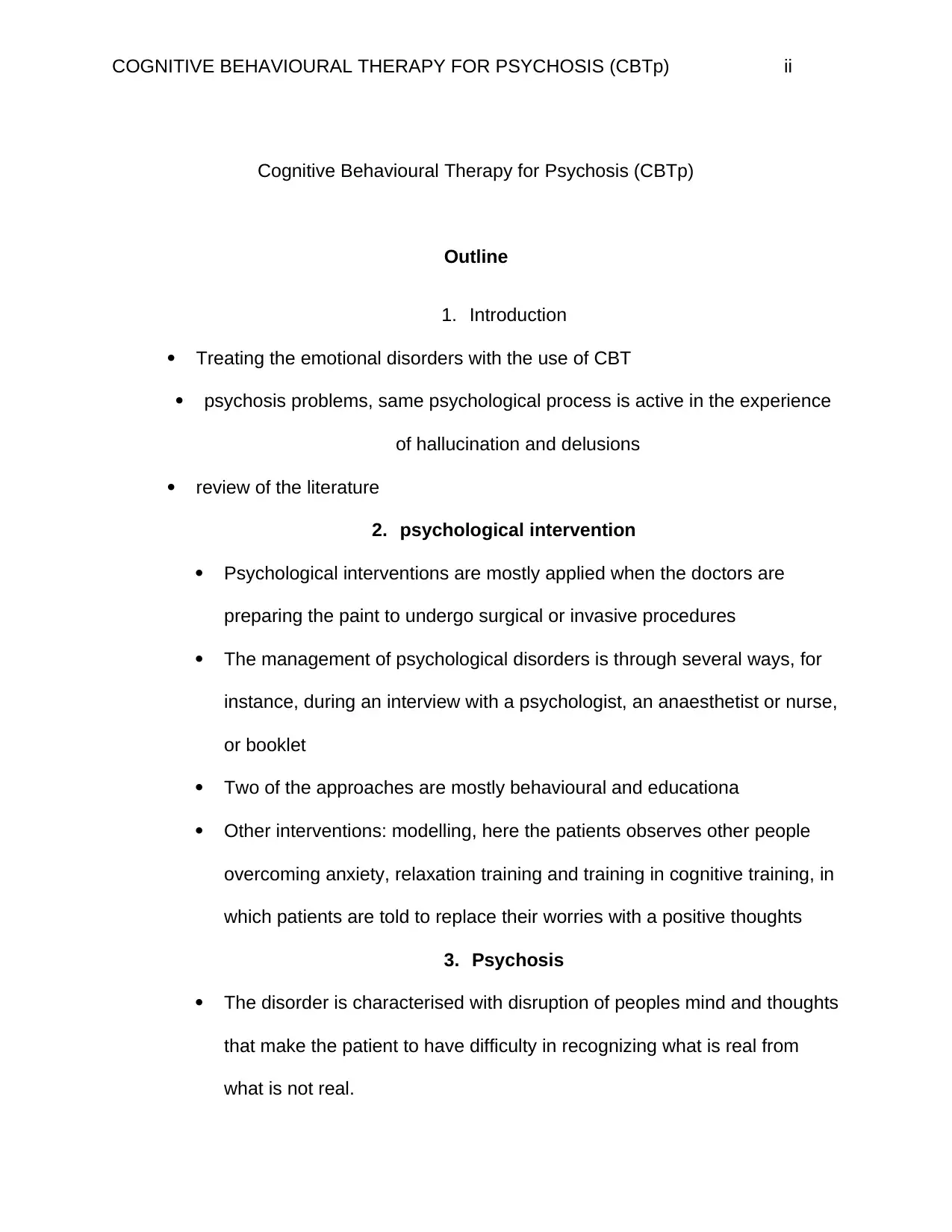
COGNITIVE BEHAVIOURAL THERAPY FOR PSYCHOSIS (CBTp) ii
Cognitive Behavioural Therapy for Psychosis (CBTp)
Outline
1. Introduction
Treating the emotional disorders with the use of CBT
psychosis problems, same psychological process is active in the experience
of hallucination and delusions
review of the literature
2. psychological intervention
Psychological interventions are mostly applied when the doctors are
preparing the paint to undergo surgical or invasive procedures
The management of psychological disorders is through several ways, for
instance, during an interview with a psychologist, an anaesthetist or nurse,
or booklet
Two of the approaches are mostly behavioural and educationa
Other interventions: modelling, here the patients observes other people
overcoming anxiety, relaxation training and training in cognitive training, in
which patients are told to replace their worries with a positive thoughts
3. Psychosis
The disorder is characterised with disruption of peoples mind and thoughts
that make the patient to have difficulty in recognizing what is real from
what is not real.
Cognitive Behavioural Therapy for Psychosis (CBTp)
Outline
1. Introduction
Treating the emotional disorders with the use of CBT
psychosis problems, same psychological process is active in the experience
of hallucination and delusions
review of the literature
2. psychological intervention
Psychological interventions are mostly applied when the doctors are
preparing the paint to undergo surgical or invasive procedures
The management of psychological disorders is through several ways, for
instance, during an interview with a psychologist, an anaesthetist or nurse,
or booklet
Two of the approaches are mostly behavioural and educationa
Other interventions: modelling, here the patients observes other people
overcoming anxiety, relaxation training and training in cognitive training, in
which patients are told to replace their worries with a positive thoughts
3. Psychosis
The disorder is characterised with disruption of peoples mind and thoughts
that make the patient to have difficulty in recognizing what is real from
what is not real.
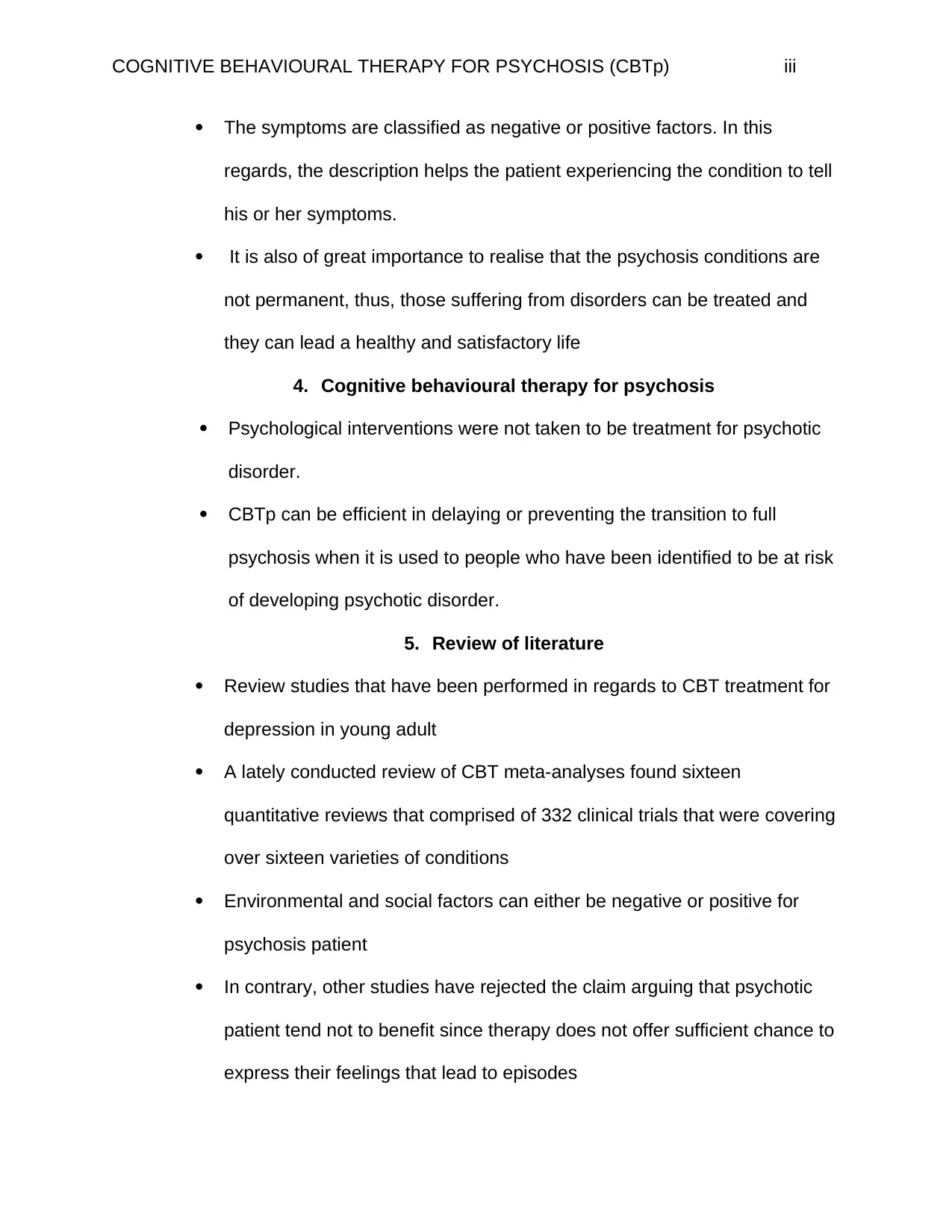
COGNITIVE BEHAVIOURAL THERAPY FOR PSYCHOSIS (CBTp) iii
The symptoms are classified as negative or positive factors. In this
regards, the description helps the patient experiencing the condition to tell
his or her symptoms.
It is also of great importance to realise that the psychosis conditions are
not permanent, thus, those suffering from disorders can be treated and
they can lead a healthy and satisfactory life
4. Cognitive behavioural therapy for psychosis
Psychological interventions were not taken to be treatment for psychotic
disorder.
CBTp can be efficient in delaying or preventing the transition to full
psychosis when it is used to people who have been identified to be at risk
of developing psychotic disorder.
5. Review of literature
Review studies that have been performed in regards to CBT treatment for
depression in young adult
A lately conducted review of CBT meta-analyses found sixteen
quantitative reviews that comprised of 332 clinical trials that were covering
over sixteen varieties of conditions
Environmental and social factors can either be negative or positive for
psychosis patient
In contrary, other studies have rejected the claim arguing that psychotic
patient tend not to benefit since therapy does not offer sufficient chance to
express their feelings that lead to episodes
The symptoms are classified as negative or positive factors. In this
regards, the description helps the patient experiencing the condition to tell
his or her symptoms.
It is also of great importance to realise that the psychosis conditions are
not permanent, thus, those suffering from disorders can be treated and
they can lead a healthy and satisfactory life
4. Cognitive behavioural therapy for psychosis
Psychological interventions were not taken to be treatment for psychotic
disorder.
CBTp can be efficient in delaying or preventing the transition to full
psychosis when it is used to people who have been identified to be at risk
of developing psychotic disorder.
5. Review of literature
Review studies that have been performed in regards to CBT treatment for
depression in young adult
A lately conducted review of CBT meta-analyses found sixteen
quantitative reviews that comprised of 332 clinical trials that were covering
over sixteen varieties of conditions
Environmental and social factors can either be negative or positive for
psychosis patient
In contrary, other studies have rejected the claim arguing that psychotic
patient tend not to benefit since therapy does not offer sufficient chance to
express their feelings that lead to episodes
⊘ This is a preview!⊘
Do you want full access?
Subscribe today to unlock all pages.

Trusted by 1+ million students worldwide
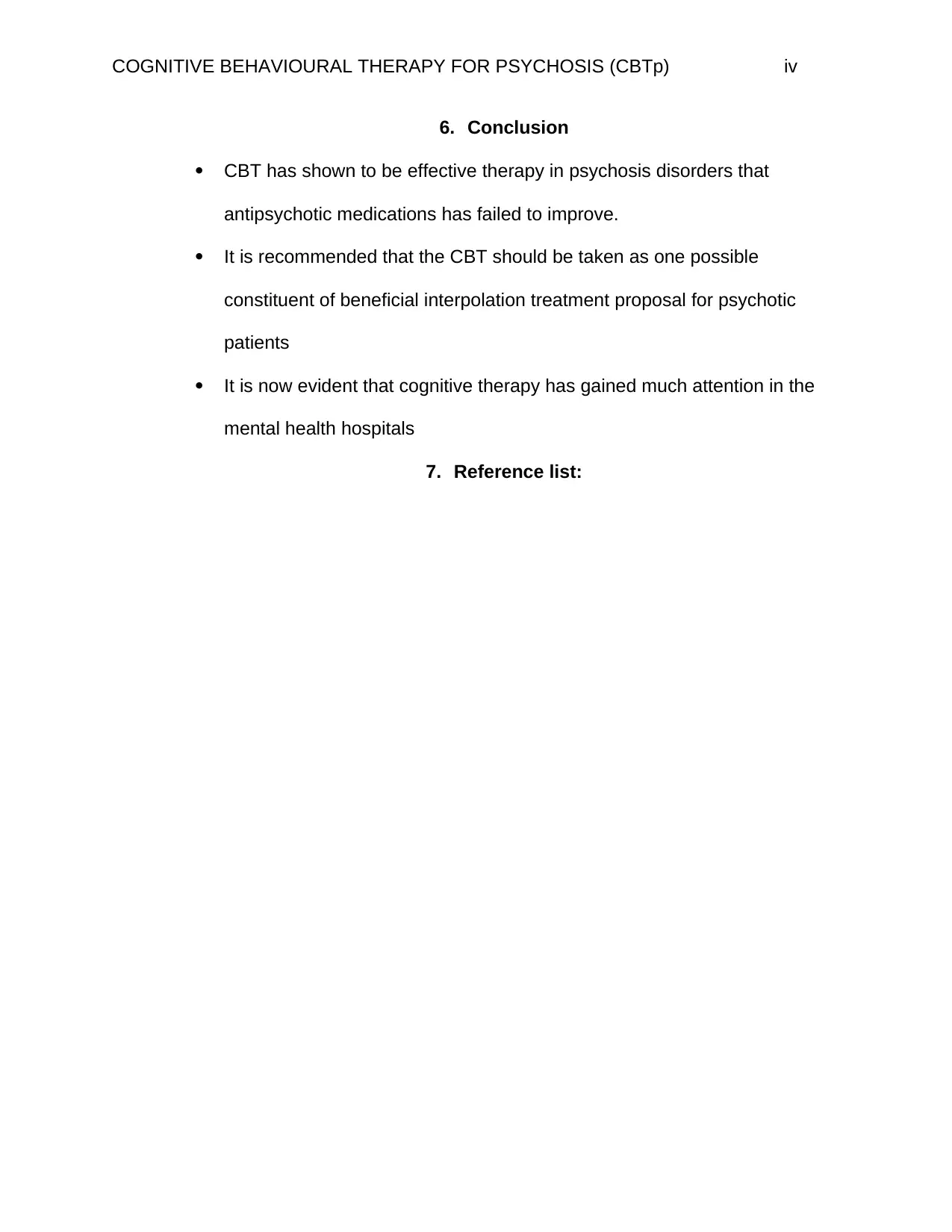
COGNITIVE BEHAVIOURAL THERAPY FOR PSYCHOSIS (CBTp) iv
6. Conclusion
CBT has shown to be effective therapy in psychosis disorders that
antipsychotic medications has failed to improve.
It is recommended that the CBT should be taken as one possible
constituent of beneficial interpolation treatment proposal for psychotic
patients
It is now evident that cognitive therapy has gained much attention in the
mental health hospitals
7. Reference list:
6. Conclusion
CBT has shown to be effective therapy in psychosis disorders that
antipsychotic medications has failed to improve.
It is recommended that the CBT should be taken as one possible
constituent of beneficial interpolation treatment proposal for psychotic
patients
It is now evident that cognitive therapy has gained much attention in the
mental health hospitals
7. Reference list:
Paraphrase This Document
Need a fresh take? Get an instant paraphrase of this document with our AI Paraphraser

COGNITIVE BEHAVIOURAL THERAPY FOR PSYCHOSIS (CBTp) v
Abstract
There has been a recommendable achievement in clinical treatment of the collective
emotional disorder with an application of cognitive behavioral methods based on
therapy for psychosis. The client was first experiencing anxiety, through indirect and
direct results of psychosis signs. The client was put in 12 weeks under cognitive
behavioral therapy (CBT) on a group. In psychosis problems, a same psychological
process is active in the experience of hallucination and delusions. For example,
persecutory delusions are perceived as the threat beliefs which are attempts by the
patients to make sense of her or his personal experience. Psychological interventions
are mostly applied when the doctors are preparing the paint to undergo surgical or
invasive procedures. They aim at helping one to cope with a procedure or reduce the
anxiety in people before surgery. The author concludes that CBT group in an individual
with the first stage of psychosis that focuses on management of anxiety can be effective
ways of eliminating associated depression, stress and anxiety levels. This model is
applicable for use in health centers for the community.
Key Words: Cognitive behaviour therapy, Anxiety, Distress, Intervention
Abstract
There has been a recommendable achievement in clinical treatment of the collective
emotional disorder with an application of cognitive behavioral methods based on
therapy for psychosis. The client was first experiencing anxiety, through indirect and
direct results of psychosis signs. The client was put in 12 weeks under cognitive
behavioral therapy (CBT) on a group. In psychosis problems, a same psychological
process is active in the experience of hallucination and delusions. For example,
persecutory delusions are perceived as the threat beliefs which are attempts by the
patients to make sense of her or his personal experience. Psychological interventions
are mostly applied when the doctors are preparing the paint to undergo surgical or
invasive procedures. They aim at helping one to cope with a procedure or reduce the
anxiety in people before surgery. The author concludes that CBT group in an individual
with the first stage of psychosis that focuses on management of anxiety can be effective
ways of eliminating associated depression, stress and anxiety levels. This model is
applicable for use in health centers for the community.
Key Words: Cognitive behaviour therapy, Anxiety, Distress, Intervention
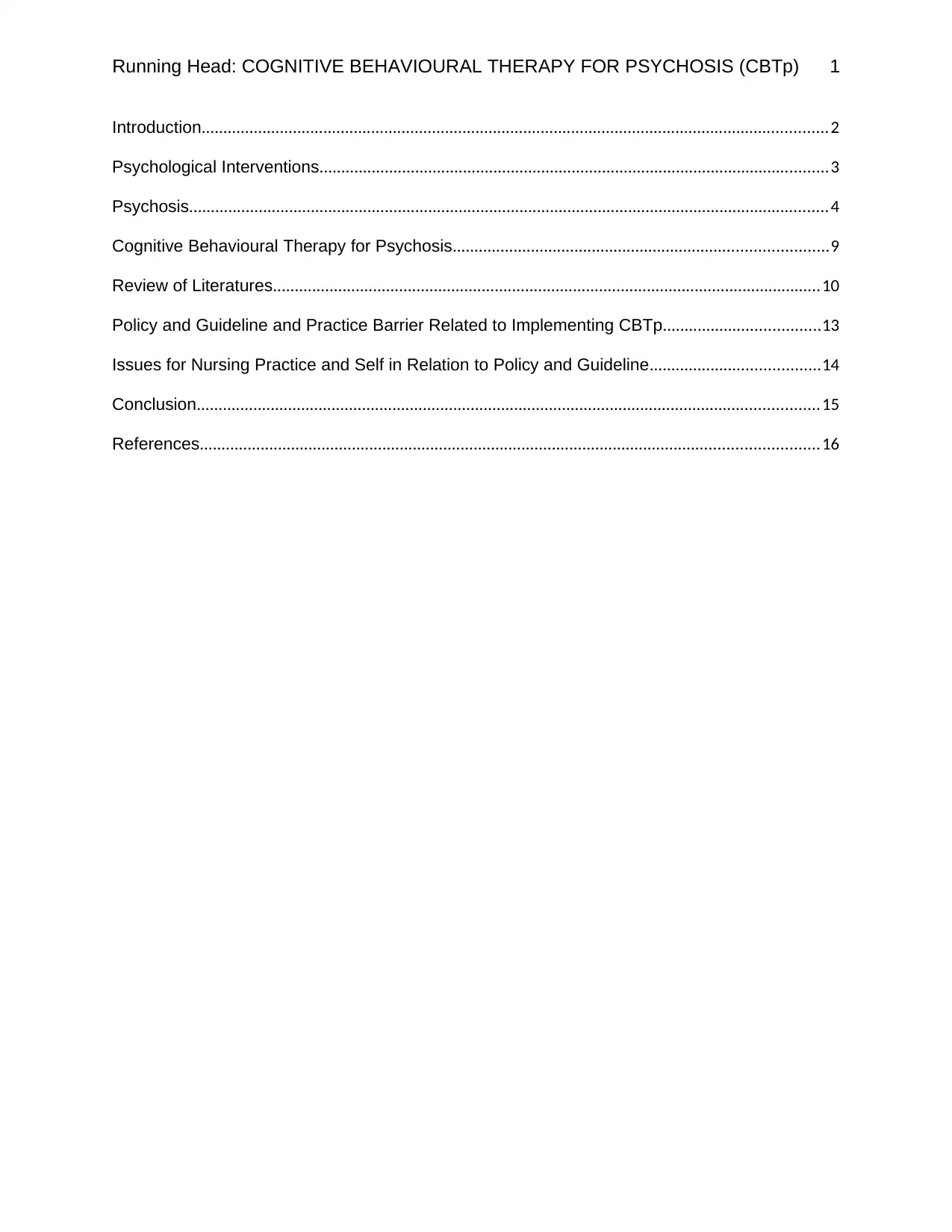
Running Head: COGNITIVE BEHAVIOURAL THERAPY FOR PSYCHOSIS (CBTp) 1
Introduction................................................................................................................................................2
Psychological Interventions.....................................................................................................................3
Psychosis...................................................................................................................................................4
Cognitive Behavioural Therapy for Psychosis......................................................................................9
Review of Literatures..............................................................................................................................10
Policy and Guideline and Practice Barrier Related to Implementing CBTp....................................13
Issues for Nursing Practice and Self in Relation to Policy and Guideline.......................................14
Conclusion...............................................................................................................................................15
References..............................................................................................................................................16
Introduction................................................................................................................................................2
Psychological Interventions.....................................................................................................................3
Psychosis...................................................................................................................................................4
Cognitive Behavioural Therapy for Psychosis......................................................................................9
Review of Literatures..............................................................................................................................10
Policy and Guideline and Practice Barrier Related to Implementing CBTp....................................13
Issues for Nursing Practice and Self in Relation to Policy and Guideline.......................................14
Conclusion...............................................................................................................................................15
References..............................................................................................................................................16
⊘ This is a preview!⊘
Do you want full access?
Subscribe today to unlock all pages.

Trusted by 1+ million students worldwide

COGNITIVE BEHAVIOURAL THERAPY FOR PSYCHOSIS (CBTp) 2
Cognitive Behavioural Therapy for Psychosis (CBTp)
Introduction
The recent studies have shown a success in a clinical trial with regards to
treating emotional conditions with the use of cognitive behavioral therapy basing on the
theoretical models (Berry, Haddock, Kellett, Roberts, Drake, & Barrowclough, 2015).
For instance, in the disorders of anxiety, the prevailing fear is tested in behavioral
approaches to help in reducing the symptoms. Additionally, in the depressive disorders,
medics lift the moods by re-evaluating the negative beliefs of the limiting and self-
excessive rumination. In psychosis problems, the same psychological process is active
in the experience of hallucination and delusions. For example, persecutory delusions
are perceived as the threat beliefs which are attempts by the patients to make sense of
her or his personal experience. On the other hand, hallucinations are perceived as
problematic when the patient interprets them as representing destructive and powerful
forces (Kråkvik, Gråwe, Hagen & Stiles, 2013).
Thus, in CBTp, thoughts that are seen as fearful are re-evaluated keenly; there is
a slow reversal of withdrawal from social contact and activity; while the feelings of
control, self-worth, and hope are mostly fostered. The approach employed is based on
giving the patients with disorder time to reflect on their experience and, most vital, plans
and strategies are developed from the discussion. The center discussion of this study
will be on the recent development with regards to CBTp with their literature reviews, the
evidence of its effectiveness and discuss the benefits that the patient will get from the
approach. The study intends to discuss the purpose and effectiveness of the CBTp
from both the practical and theoretical perspective. Additionally, the study will review
Cognitive Behavioural Therapy for Psychosis (CBTp)
Introduction
The recent studies have shown a success in a clinical trial with regards to
treating emotional conditions with the use of cognitive behavioral therapy basing on the
theoretical models (Berry, Haddock, Kellett, Roberts, Drake, & Barrowclough, 2015).
For instance, in the disorders of anxiety, the prevailing fear is tested in behavioral
approaches to help in reducing the symptoms. Additionally, in the depressive disorders,
medics lift the moods by re-evaluating the negative beliefs of the limiting and self-
excessive rumination. In psychosis problems, the same psychological process is active
in the experience of hallucination and delusions. For example, persecutory delusions
are perceived as the threat beliefs which are attempts by the patients to make sense of
her or his personal experience. On the other hand, hallucinations are perceived as
problematic when the patient interprets them as representing destructive and powerful
forces (Kråkvik, Gråwe, Hagen & Stiles, 2013).
Thus, in CBTp, thoughts that are seen as fearful are re-evaluated keenly; there is
a slow reversal of withdrawal from social contact and activity; while the feelings of
control, self-worth, and hope are mostly fostered. The approach employed is based on
giving the patients with disorder time to reflect on their experience and, most vital, plans
and strategies are developed from the discussion. The center discussion of this study
will be on the recent development with regards to CBTp with their literature reviews, the
evidence of its effectiveness and discuss the benefits that the patient will get from the
approach. The study intends to discuss the purpose and effectiveness of the CBTp
from both the practical and theoretical perspective. Additionally, the study will review
Paraphrase This Document
Need a fresh take? Get an instant paraphrase of this document with our AI Paraphraser
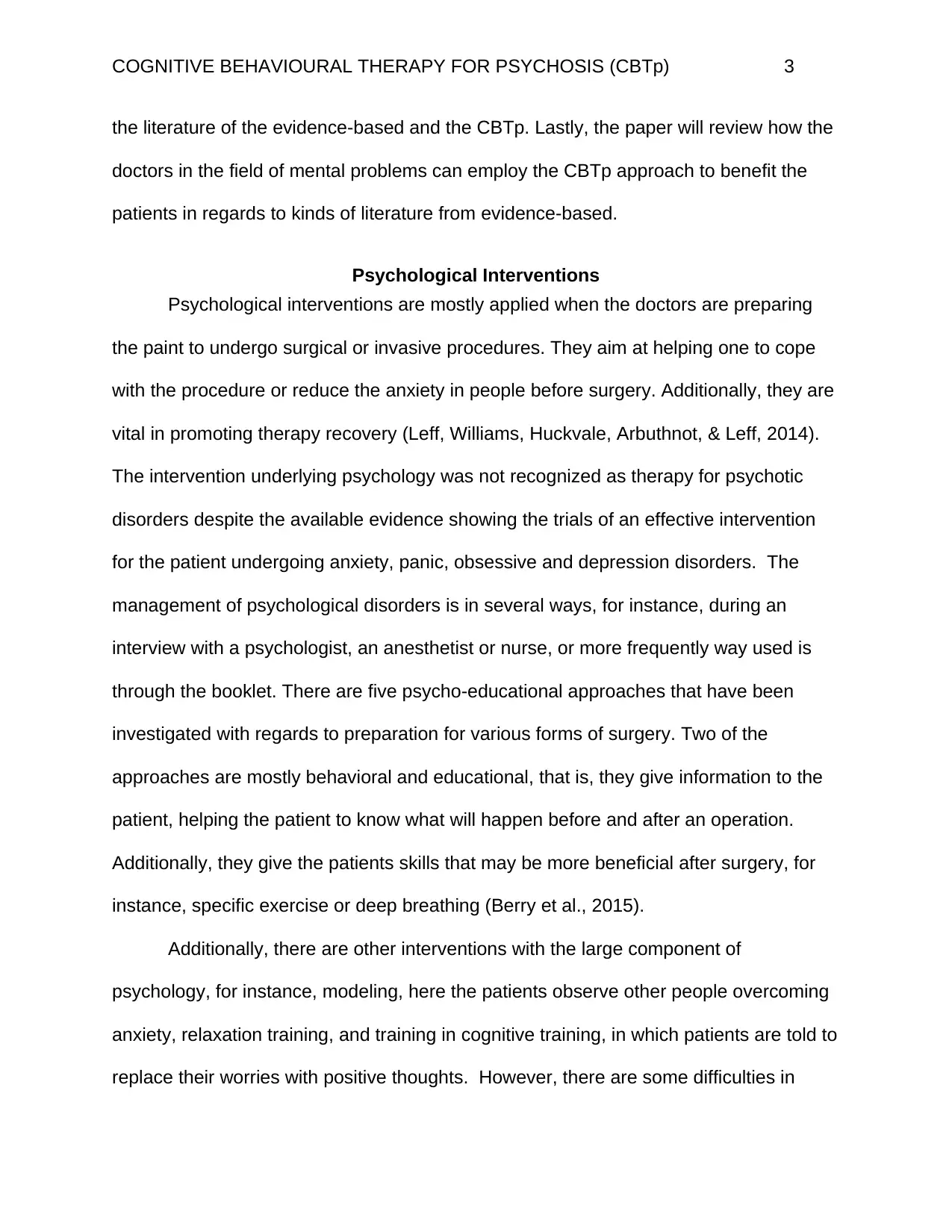
COGNITIVE BEHAVIOURAL THERAPY FOR PSYCHOSIS (CBTp) 3
the literature of the evidence-based and the CBTp. Lastly, the paper will review how the
doctors in the field of mental problems can employ the CBTp approach to benefit the
patients in regards to kinds of literature from evidence-based.
Psychological Interventions
Psychological interventions are mostly applied when the doctors are preparing
the paint to undergo surgical or invasive procedures. They aim at helping one to cope
with the procedure or reduce the anxiety in people before surgery. Additionally, they are
vital in promoting therapy recovery (Leff, Williams, Huckvale, Arbuthnot, & Leff, 2014).
The intervention underlying psychology was not recognized as therapy for psychotic
disorders despite the available evidence showing the trials of an effective intervention
for the patient undergoing anxiety, panic, obsessive and depression disorders. The
management of psychological disorders is in several ways, for instance, during an
interview with a psychologist, an anesthetist or nurse, or more frequently way used is
through the booklet. There are five psycho-educational approaches that have been
investigated with regards to preparation for various forms of surgery. Two of the
approaches are mostly behavioral and educational, that is, they give information to the
patient, helping the patient to know what will happen before and after an operation.
Additionally, they give the patients skills that may be more beneficial after surgery, for
instance, specific exercise or deep breathing (Berry et al., 2015).
Additionally, there are other interventions with the large component of
psychology, for instance, modeling, here the patients observe other people overcoming
anxiety, relaxation training, and training in cognitive training, in which patients are told to
replace their worries with positive thoughts. However, there are some difficulties in
the literature of the evidence-based and the CBTp. Lastly, the paper will review how the
doctors in the field of mental problems can employ the CBTp approach to benefit the
patients in regards to kinds of literature from evidence-based.
Psychological Interventions
Psychological interventions are mostly applied when the doctors are preparing
the paint to undergo surgical or invasive procedures. They aim at helping one to cope
with the procedure or reduce the anxiety in people before surgery. Additionally, they are
vital in promoting therapy recovery (Leff, Williams, Huckvale, Arbuthnot, & Leff, 2014).
The intervention underlying psychology was not recognized as therapy for psychotic
disorders despite the available evidence showing the trials of an effective intervention
for the patient undergoing anxiety, panic, obsessive and depression disorders. The
management of psychological disorders is in several ways, for instance, during an
interview with a psychologist, an anesthetist or nurse, or more frequently way used is
through the booklet. There are five psycho-educational approaches that have been
investigated with regards to preparation for various forms of surgery. Two of the
approaches are mostly behavioral and educational, that is, they give information to the
patient, helping the patient to know what will happen before and after an operation.
Additionally, they give the patients skills that may be more beneficial after surgery, for
instance, specific exercise or deep breathing (Berry et al., 2015).
Additionally, there are other interventions with the large component of
psychology, for instance, modeling, here the patients observe other people overcoming
anxiety, relaxation training, and training in cognitive training, in which patients are told to
replace their worries with positive thoughts. However, there are some difficulties in

COGNITIVE BEHAVIOURAL THERAPY FOR PSYCHOSIS (CBTp) 4
evaluating the studies that have employed this intervention, even though there are
evidences to show that all the interventions have potential, especially when one
combines the educational and psychological interventions (Kråkvik, Gråwe, Hagen &
Stiles, 2013).
Psychosis
Most of us relate psychosis with a break of reality. Thus, the disorder is
characterized by disruption of peoples mind and thoughts that make the patient have
difficulty in recognizing what is real from what is not real. These disruptions are mostly
experienced as hearing, seeing, and sometimes, believing things that are not real or
available. It is vital to know that psychosis is a symptom and not an illness. It is
estimated that over 100,000 young people experience the disorder per year in the
United State (Turkington, Kingdon & Turner, 2002). In contrary, a recent study has
shown that psychosis is taken to be an umbrella for the variety of symptoms. Thus, the
symptoms are classified as negative or positive factors. In this regards, the description
helps the patient experiencing the condition to tell his or her symptoms.
To break it down further, the positive signs are those that can add some
unreality. Thus, one can have a visual hallucination. Thus, he or she sees things that
are not available (Dixon et al., 2009). Also, the positive symptoms influence one's
belief, thus, the patient ends up believing in things that do not make any sense to others
(delusion). On the other hand, negative symptoms are those that make one feel that
something vital has been taken from them, for example, lack of emotion or enjoyment.
In this regards, it can be seen that psychosis is a combination of one’s neurological,
unique genetic, environmental and psychological factors. World Health Organization
evaluating the studies that have employed this intervention, even though there are
evidences to show that all the interventions have potential, especially when one
combines the educational and psychological interventions (Kråkvik, Gråwe, Hagen &
Stiles, 2013).
Psychosis
Most of us relate psychosis with a break of reality. Thus, the disorder is
characterized by disruption of peoples mind and thoughts that make the patient have
difficulty in recognizing what is real from what is not real. These disruptions are mostly
experienced as hearing, seeing, and sometimes, believing things that are not real or
available. It is vital to know that psychosis is a symptom and not an illness. It is
estimated that over 100,000 young people experience the disorder per year in the
United State (Turkington, Kingdon & Turner, 2002). In contrary, a recent study has
shown that psychosis is taken to be an umbrella for the variety of symptoms. Thus, the
symptoms are classified as negative or positive factors. In this regards, the description
helps the patient experiencing the condition to tell his or her symptoms.
To break it down further, the positive signs are those that can add some
unreality. Thus, one can have a visual hallucination. Thus, he or she sees things that
are not available (Dixon et al., 2009). Also, the positive symptoms influence one's
belief, thus, the patient ends up believing in things that do not make any sense to others
(delusion). On the other hand, negative symptoms are those that make one feel that
something vital has been taken from them, for example, lack of emotion or enjoyment.
In this regards, it can be seen that psychosis is a combination of one’s neurological,
unique genetic, environmental and psychological factors. World Health Organization
⊘ This is a preview!⊘
Do you want full access?
Subscribe today to unlock all pages.

Trusted by 1+ million students worldwide
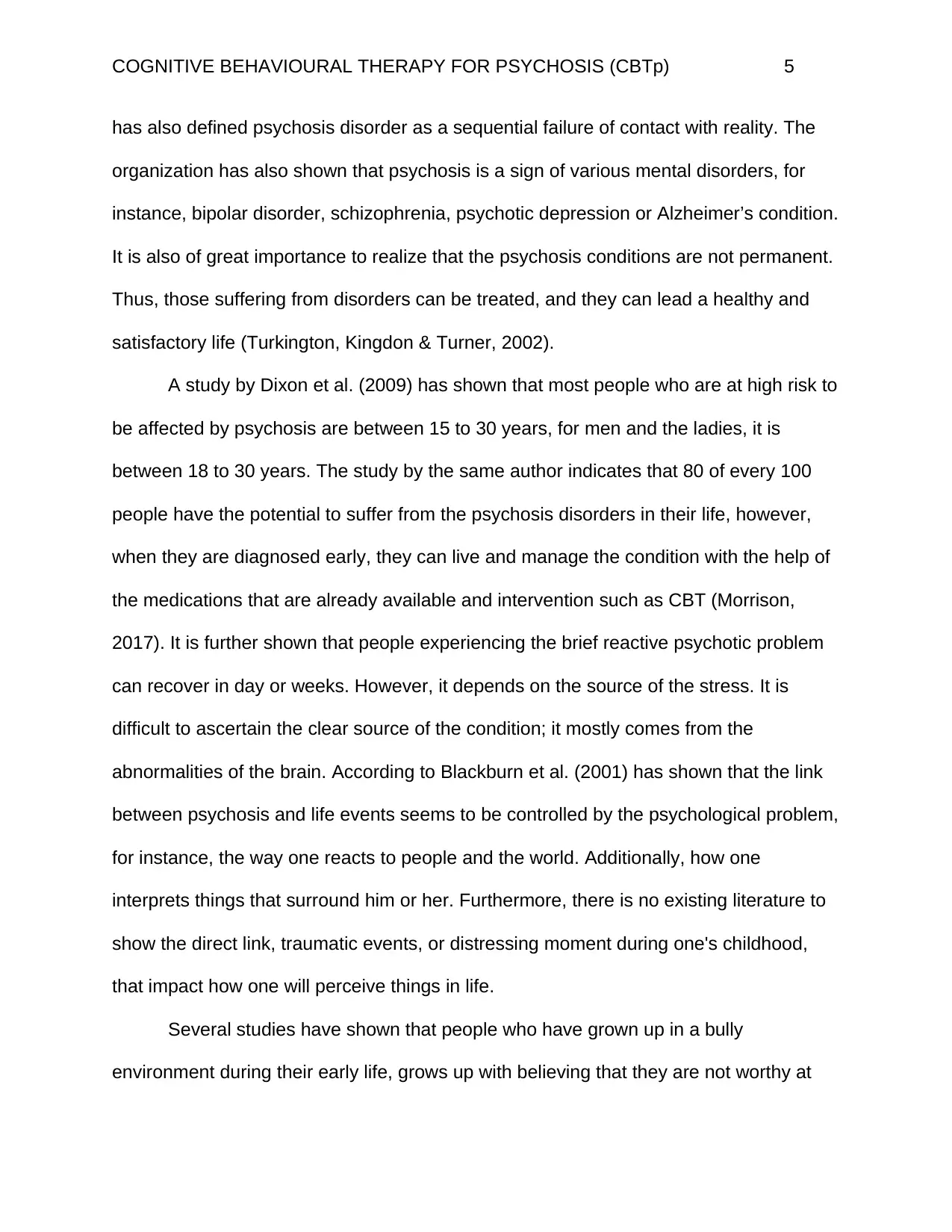
COGNITIVE BEHAVIOURAL THERAPY FOR PSYCHOSIS (CBTp) 5
has also defined psychosis disorder as a sequential failure of contact with reality. The
organization has also shown that psychosis is a sign of various mental disorders, for
instance, bipolar disorder, schizophrenia, psychotic depression or Alzheimer’s condition.
It is also of great importance to realize that the psychosis conditions are not permanent.
Thus, those suffering from disorders can be treated, and they can lead a healthy and
satisfactory life (Turkington, Kingdon & Turner, 2002).
A study by Dixon et al. (2009) has shown that most people who are at high risk to
be affected by psychosis are between 15 to 30 years, for men and the ladies, it is
between 18 to 30 years. The study by the same author indicates that 80 of every 100
people have the potential to suffer from the psychosis disorders in their life, however,
when they are diagnosed early, they can live and manage the condition with the help of
the medications that are already available and intervention such as CBT (Morrison,
2017). It is further shown that people experiencing the brief reactive psychotic problem
can recover in day or weeks. However, it depends on the source of the stress. It is
difficult to ascertain the clear source of the condition; it mostly comes from the
abnormalities of the brain. According to Blackburn et al. (2001) has shown that the link
between psychosis and life events seems to be controlled by the psychological problem,
for instance, the way one reacts to people and the world. Additionally, how one
interprets things that surround him or her. Furthermore, there is no existing literature to
show the direct link, traumatic events, or distressing moment during one's childhood,
that impact how one will perceive things in life.
Several studies have shown that people who have grown up in a bully
environment during their early life, grows up with believing that they are not worthy at
has also defined psychosis disorder as a sequential failure of contact with reality. The
organization has also shown that psychosis is a sign of various mental disorders, for
instance, bipolar disorder, schizophrenia, psychotic depression or Alzheimer’s condition.
It is also of great importance to realize that the psychosis conditions are not permanent.
Thus, those suffering from disorders can be treated, and they can lead a healthy and
satisfactory life (Turkington, Kingdon & Turner, 2002).
A study by Dixon et al. (2009) has shown that most people who are at high risk to
be affected by psychosis are between 15 to 30 years, for men and the ladies, it is
between 18 to 30 years. The study by the same author indicates that 80 of every 100
people have the potential to suffer from the psychosis disorders in their life, however,
when they are diagnosed early, they can live and manage the condition with the help of
the medications that are already available and intervention such as CBT (Morrison,
2017). It is further shown that people experiencing the brief reactive psychotic problem
can recover in day or weeks. However, it depends on the source of the stress. It is
difficult to ascertain the clear source of the condition; it mostly comes from the
abnormalities of the brain. According to Blackburn et al. (2001) has shown that the link
between psychosis and life events seems to be controlled by the psychological problem,
for instance, the way one reacts to people and the world. Additionally, how one
interprets things that surround him or her. Furthermore, there is no existing literature to
show the direct link, traumatic events, or distressing moment during one's childhood,
that impact how one will perceive things in life.
Several studies have shown that people who have grown up in a bully
environment during their early life, grows up with believing that they are not worthy at
Paraphrase This Document
Need a fresh take? Get an instant paraphrase of this document with our AI Paraphraser
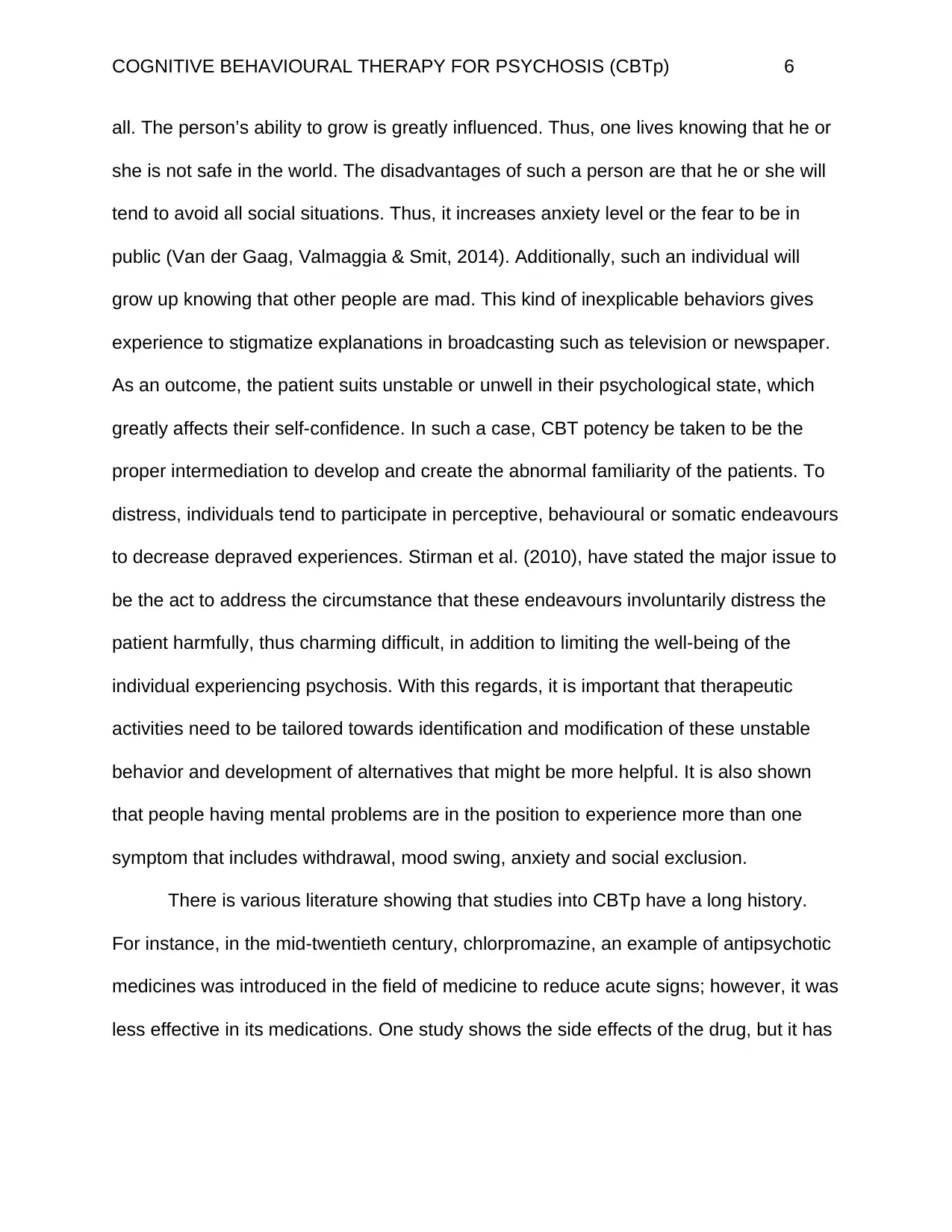
COGNITIVE BEHAVIOURAL THERAPY FOR PSYCHOSIS (CBTp) 6
all. The person’s ability to grow is greatly influenced. Thus, one lives knowing that he or
she is not safe in the world. The disadvantages of such a person are that he or she will
tend to avoid all social situations. Thus, it increases anxiety level or the fear to be in
public (Van der Gaag, Valmaggia & Smit, 2014). Additionally, such an individual will
grow up knowing that other people are mad. This kind of inexplicable behaviors gives
experience to stigmatize explanations in broadcasting such as television or newspaper.
As an outcome, the patient suits unstable or unwell in their psychological state, which
greatly affects their self-confidence. In such a case, CBT potency be taken to be the
proper intermediation to develop and create the abnormal familiarity of the patients. To
distress, individuals tend to participate in perceptive, behavioural or somatic endeavours
to decrease depraved experiences. Stirman et al. (2010), have stated the major issue to
be the act to address the circumstance that these endeavours involuntarily distress the
patient harmfully, thus charming difficult, in addition to limiting the well-being of the
individual experiencing psychosis. With this regards, it is important that therapeutic
activities need to be tailored towards identification and modification of these unstable
behavior and development of alternatives that might be more helpful. It is also shown
that people having mental problems are in the position to experience more than one
symptom that includes withdrawal, mood swing, anxiety and social exclusion.
There is various literature showing that studies into CBTp have a long history.
For instance, in the mid-twentieth century, chlorpromazine, an example of antipsychotic
medicines was introduced in the field of medicine to reduce acute signs; however, it was
less effective in its medications. One study shows the side effects of the drug, but it has
all. The person’s ability to grow is greatly influenced. Thus, one lives knowing that he or
she is not safe in the world. The disadvantages of such a person are that he or she will
tend to avoid all social situations. Thus, it increases anxiety level or the fear to be in
public (Van der Gaag, Valmaggia & Smit, 2014). Additionally, such an individual will
grow up knowing that other people are mad. This kind of inexplicable behaviors gives
experience to stigmatize explanations in broadcasting such as television or newspaper.
As an outcome, the patient suits unstable or unwell in their psychological state, which
greatly affects their self-confidence. In such a case, CBT potency be taken to be the
proper intermediation to develop and create the abnormal familiarity of the patients. To
distress, individuals tend to participate in perceptive, behavioural or somatic endeavours
to decrease depraved experiences. Stirman et al. (2010), have stated the major issue to
be the act to address the circumstance that these endeavours involuntarily distress the
patient harmfully, thus charming difficult, in addition to limiting the well-being of the
individual experiencing psychosis. With this regards, it is important that therapeutic
activities need to be tailored towards identification and modification of these unstable
behavior and development of alternatives that might be more helpful. It is also shown
that people having mental problems are in the position to experience more than one
symptom that includes withdrawal, mood swing, anxiety and social exclusion.
There is various literature showing that studies into CBTp have a long history.
For instance, in the mid-twentieth century, chlorpromazine, an example of antipsychotic
medicines was introduced in the field of medicine to reduce acute signs; however, it was
less effective in its medications. One study shows the side effects of the drug, but it has

COGNITIVE BEHAVIOURAL THERAPY FOR PSYCHOSIS (CBTp) 7
been widely used to reduce the dependence on long-term hospitalization and physical
restraints.
Cognitive Behavioural Therapy
Cognitive behavioral therapy (CBT) is psychotherapy that is goal oriented and
short-term treatment that is a more of hands-on, experimental intervention in solving the
problem. It aims at changing the pattern of behavior or thinking that is behind the
difficulties of people, thus, changing the way they feel (Klein & Knight, 2005). The
approach has been applied in treating several difficulties in human beings, for instance,
sleeping problems, drug and alcohol abuse, relationship difficulties, depression and
anxiety problems. CBT majors on how to change the behavior and attitudes of the
person through focusing on the images, thoughts, attitudes, and beliefs held and the
way this process relates to person behaviors and a proper way of managing problems
from emotions (Turkington, Kingdon & Turner, 2002).
From the available literature, the primary treatment for psychotic disorders has
been based on the use of antipsychotic medicines. However, there are several side
effects that are as a result of the use of the medicines. Additionally, not all people
respond well to the medicine. Thus, about 40% of patients have poor response to the
medicines, thus, continues to show the psychotic symptoms (Wykes, Steel, Everitt &
Tarrier, 2008). In contrast, CBT is short, mostly taking a minimum of five and maximum
of ten months for emotional disorders. In most cases, the patients are needed to attend
one session per week which mostly lasts for fifty minutes. During the session, the
therapist and patient work together to identify the prevailing problems and develop ways
to tackle the condition. Additionally, CBT is advantageous in a manner that it helps the
been widely used to reduce the dependence on long-term hospitalization and physical
restraints.
Cognitive Behavioural Therapy
Cognitive behavioral therapy (CBT) is psychotherapy that is goal oriented and
short-term treatment that is a more of hands-on, experimental intervention in solving the
problem. It aims at changing the pattern of behavior or thinking that is behind the
difficulties of people, thus, changing the way they feel (Klein & Knight, 2005). The
approach has been applied in treating several difficulties in human beings, for instance,
sleeping problems, drug and alcohol abuse, relationship difficulties, depression and
anxiety problems. CBT majors on how to change the behavior and attitudes of the
person through focusing on the images, thoughts, attitudes, and beliefs held and the
way this process relates to person behaviors and a proper way of managing problems
from emotions (Turkington, Kingdon & Turner, 2002).
From the available literature, the primary treatment for psychotic disorders has
been based on the use of antipsychotic medicines. However, there are several side
effects that are as a result of the use of the medicines. Additionally, not all people
respond well to the medicine. Thus, about 40% of patients have poor response to the
medicines, thus, continues to show the psychotic symptoms (Wykes, Steel, Everitt &
Tarrier, 2008). In contrast, CBT is short, mostly taking a minimum of five and maximum
of ten months for emotional disorders. In most cases, the patients are needed to attend
one session per week which mostly lasts for fifty minutes. During the session, the
therapist and patient work together to identify the prevailing problems and develop ways
to tackle the condition. Additionally, CBT is advantageous in a manner that it helps the
⊘ This is a preview!⊘
Do you want full access?
Subscribe today to unlock all pages.

Trusted by 1+ million students worldwide
1 out of 28
Related Documents
Your All-in-One AI-Powered Toolkit for Academic Success.
+13062052269
info@desklib.com
Available 24*7 on WhatsApp / Email
![[object Object]](/_next/static/media/star-bottom.7253800d.svg)
Unlock your academic potential
Copyright © 2020–2025 A2Z Services. All Rights Reserved. Developed and managed by ZUCOL.





